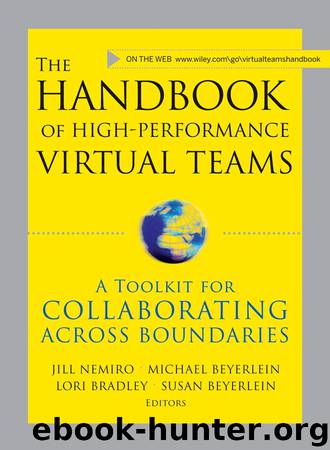The Handbook of High Performance Virtual Teams by Jill Nemiro & Michael Beyerlein & Lori Bradley & Susan Beyerlein

Author:Jill Nemiro & Michael Beyerlein & Lori Bradley & Susan Beyerlein
Language: eng
Format: epub
ISBN: 9781119177821
Publisher: Wiley
Published: 2015-06-08T16:00:00+00:00
CHARACTERISTICS OF EFFECTIVE COMPETENCY DEVELOPMENT PROGRAMS FOR VIRTUAL COLLABORATION
To help teams face the key challenges and develop the success factors of virtual teams identified above, learning and development programs for virtual collaboration competency must have several characteristics. The first three characteristics we present are specific to training and development for virtual teams. The fourth articulates best practices for action learning in organizations.
First, they must work with intact, complete teams. The entire team is part of and is affected by complexity, invisibility, and restricted communication and must develop shared understanding, trust, and effective communication. Individual competency development for virtual working can bring improvements for individual learners; the challenge then is to synchronize these among the individual members in the team, where the greatest challenges are faced. Learning as a team and then implementing the output of learning immediately leads to tangible improvements much more quickly and is therefore much more stimulating.
Second, the training must use blended learning techniques: a combination of remote and face-to-face learning, complemented by individual learning activities. This is true partly for pragmatic reasons: the team is unlikely to be able to engage in training together face-to-face much because of the expenses of time and travel. More important, though, blended learning parallels the group’s own processes. Most virtual teams work together using some combination of remote, face-to-face, and individual activity. To the extent that learning is conducted in the same context as the actual work, the transfer from learning context to actual is smoother. Moreover, a mixture of learning options accommodates the complexity of different learning styles of team members, for example, due to differences in personality or cultural background.
Third, the training should reflect the fact that virtual teams are complex and that each virtual team is different from others on important dimensions. A modular approach with related yet self-contained learning modules helps to address this complexity. Furthermore, with a modularized approach, teams must identify which modules they need and which they do not early in the team process, thereby providing an initial opportunity for creating shared knowledge about the team and its process and a first step in the virtuous team process cycle.
Finally, an action-learning design is clearly warranted for training and development of virtual teams. In action-learning mode, teams work together with facilitated learning processes on real-life problems, identifying practical solutions and implementing them while paying attention to skill development and learning. When this learning mode is then adopted by intact (virtual) teams that apply it to the actual problem situations they are facing, a highly effective learning environment will be created. With this mode, team members are given sustained exposure to the need to change behavior within the team (Revans, 1980). They share responsibility for the tangible results of action-learning activities, and this focuses their efforts.
Action learning requires the use of diagnostics to help identify areas where the team will benefit most from its learning efforts. Results from team-level diagnostic instruments can also complement the modularity aspect: knowing where competency development will have the greatest
Download
This site does not store any files on its server. We only index and link to content provided by other sites. Please contact the content providers to delete copyright contents if any and email us, we'll remove relevant links or contents immediately.
Periodization Training for Sports by Tudor Bompa(8170)
The Body: A Guide for Occupants by Bill Bryson(4974)
The MacArthur Bible Commentary by John MacArthur(4749)
The Sports Rules Book by Human Kinetics(4294)
What It Really Takes to Get Into Ivy League and Other Highly Selective Colleges by Hughes Chuck(3696)
Marijuana Grower's Handbook by Ed Rosenthal(3623)
The Sprouting Book by Ann Wigmore(3543)
The Martian by Andy Weir(3309)
Salt, Fat, Acid, Heat: Mastering the Elements of Good Cooking by Nosrat Samin(3108)
The Bread Bible by Rose Levy Beranbaum(3004)
Harry Potter 4 - Harry Potter and The Goblet of Fire by J.K.Rowling(2990)
Sapiens and Homo Deus by Yuval Noah Harari(2987)
The Marketing Plan Handbook: Develop Big-Picture Marketing Plans for Pennies on the Dollar by Robert W. Bly(2975)
Classic by Mary Berry(2942)
Martha Stewart's Baking Handbook by Martha Stewart(2796)
Screenplay: The Foundations of Screenwriting by Syd Field(2574)
The Plant Paradox by Dr. Steven R. Gundry M.D(2547)
50 Economics Classics by Tom Butler-Bowdon(2523)
The Cambridge Grammar Of The English Language by Rodney Huddleston Geoffrey K. Pullum(2383)
